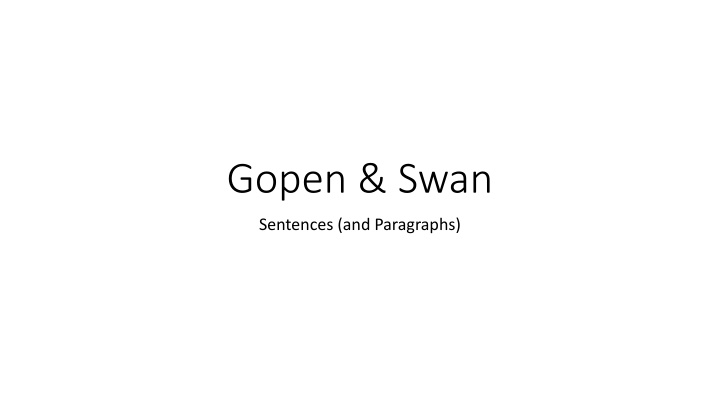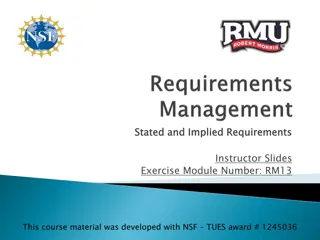
Effective Writing Guidelines: Gopen & Swan Sentences
Learn the key points for effective writing according to the guidelines from Gopen & Swan. Understand the importance of subject-verb separation and meaningful verbs in sentences and paragraphs. Discover how sentence structure can meet readers' expectations and keep them engaged throughout the text.
Download Presentation

Please find below an Image/Link to download the presentation.
The content on the website is provided AS IS for your information and personal use only. It may not be sold, licensed, or shared on other websites without obtaining consent from the author. If you encounter any issues during the download, it is possible that the publisher has removed the file from their server.
You are allowed to download the files provided on this website for personal or commercial use, subject to the condition that they are used lawfully. All files are the property of their respective owners.
The content on the website is provided AS IS for your information and personal use only. It may not be sold, licensed, or shared on other websites without obtaining consent from the author.
E N D
Presentation Transcript
Gopen & Swan Sentences (and Paragraphs)
The main points (guidelines, not rules) Subject-verb separation and meaningful verbs Readers expect grammatical verb to follow grammatical subject almost immediately (intervening words tend to be ignored) Make the verb meaningfully represent the action of the sentence Single function Readers generally expect each unit of discourse, no matter what the size, to serve a single function (e.g. to make a single point). Sentence structure that meets readers expectations [Topic position] [details] [stress position] Don't make reader construct linkages between units of writing by him- or herself.
More on sentence/clause structure The beginning of the sentence/clause (the "topic position") what the story of the sentence is about links back to familiar information and/or frames sentence "what's it about": perspective and context The end of the sentence/clause ("stress position") what the reader will remember / take away leans forward into the next sentence or other bit of writing "what's the point": primary emphasis The middle Skimmers tend to skip Details for the interested reader
The project's success, with which we are pleased, we now report.
The Central Limit Theorem, for many reasons--its beauty, its wide generality and applicability, and its agreement with empirical evidence--has been celebrated for over a century.
A significant positive correlation was evident between the substitution rate and a nucleosome score from resting human T-cells.
This database has been subject to different improvements, modifications, and extensions in structure and content over the years.
I received my degree at Carnegie Mellon, and since I live nearby, I can come in for an interview anytime.
Mapping of open chromatin regions, post-translational histone modifications and DNA methylation across a whole genome is now feasible, and new non-coding RNAs can be sensitively identified via RNA sequencing.
A sentence can have more than one stress position, but it should not have more candidates for stress than it has stress positions. How many stress positions did that sentence have?
On paragraphs and linkages between sentences It is much more complicated to think of the various expectations that readers have about paragraphs. We will continue discussion of paragraphs on Thursday. Gopen has a very long chapter (55+ pages) on paragraphs! A common (but not the only) form of paragraph defines an "issue and makes a "point" about it. Very satisfying in technical writing Other kinds of paragraphs: tell a story (can be very satisfying if well-signaled) collect together a list of facts, definitions, instructions, etc. (sometimes necessary, but usually not too satisfying)
Some heuristics for issue/point paragraphs Treat a paragraph like a sentence the beginning (first 1-3 sentences) is the topic position : the "issue" is here the end (last sentence or so) is the stress position : the "point" can be anywhere but is often here the middle of the paragraph contains the details Linking sentences together to give a paragraph "flow the topic position of each sentence should reach back to old info and frame the sentence the stress position of each sentence should have new information each sentence should lean/lead into the next Each writing unit should serve a single function simple check: the last sentence should match the first If I only read the beginning and end of the paragraph, does it express a coherent thought? More broadly, each sentence in the paragraph should support the main point of that paragraph
While doing this experiment, a problem with the calibration was observed. Before we move on, we must correct it.
Make the Asphalt be the point: Our highly-skilled engineers tested the asphalt. They heated and cooled it over 100 times in rapid succession, and they found that only minor cracking occured.
Farmers try to provide optimal growing conditions for crops by using soil additives to adjust soil pH. Garden lime, or agricultural limestone, is made from pulverized chalk, and can be used to raise the pH of the soil. Clay soil, which is naturally acidic, often requires addition of agricultural lime.
The possibility that some termini have a base composition different from that of DNA simply because they are the nearest neighbors of termini specifically recognized by the enzymes can be checked by comparing the experimental results with those expected from the nearest neighbor data.
Some last words The topic position / stress position idea can be applied to most units of writing Whatever the reader encounters first is what the reader expects the unit of writing to be about This is also where to help the reader settle in to the unit Whatever the reader encounters last is what the reader is likely to remember or emphasize This is also where to highlight new information As a first approximation, you can apply this to Clauses & Sentences Paragraphs Sections Whole articles

